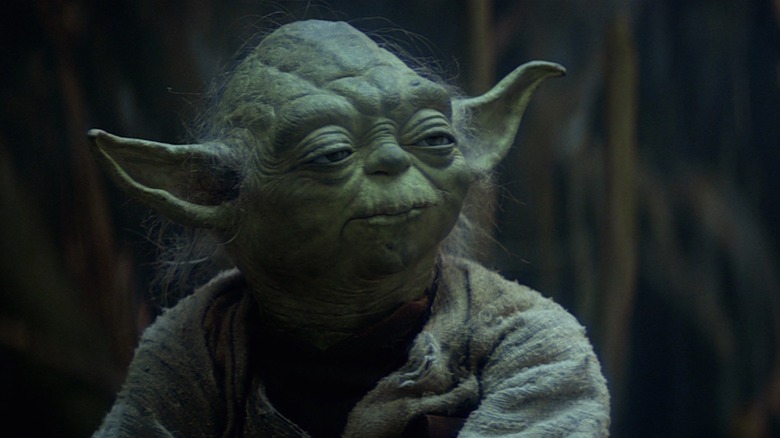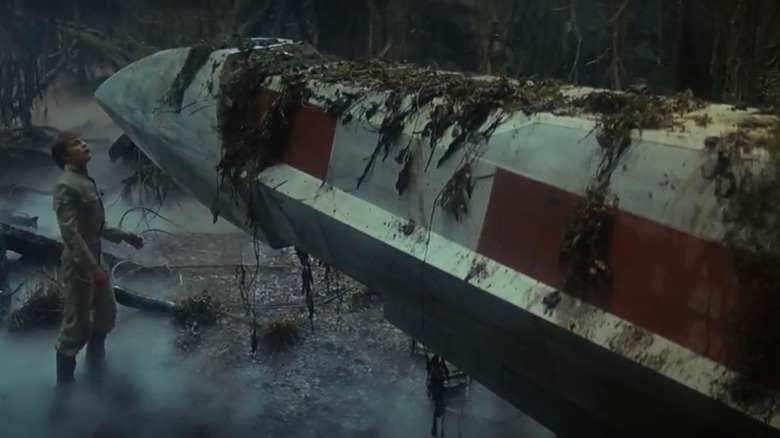Yoda's Reveal Was A Make-Or-Break Moment For The Star Wars Franchise
"The Empire Strikes Back" isn't just the best installment in the "Star Wars" saga, it's also the most important. When the second chapter of the Original Trilogy hit theaters on May 20, 1980, it blindsided audiences with tantalizing cliffhangers and astonishing reveals. The film daringly ends on an unresolved, bummer note. If George Lucas and his storytelling collaborators (primarily screenwriter Lawrence Kasdan and director Irvin Kershner) misfired on any of the key plot points, we probably wouldn't be watching "Star Wars" spin-off shows on Disney+ today.
Luke Skywalker learning the awful truth about his parentage might be the film's biggest swing, but the most integral element by far is the introduction of Yoda. With his sage observations about the Force, this squat, ancient, pea-green jedi master does more than educate the impulsive young Skywalker; he imbues the series with a soul. "[M]y ally is the Force," he says, "And a powerful ally it is. Life creates it, makes it grow. Its energy surrounds us, binds us. Luminous beings are we, not this crude matter." This is a profound, incredibly moving observation. That it lands so powerfully when spoken by a puppet is nothing short of a miracle. According to George Lucas, the realization of this miracle was anything but a given.
The creation, articulation and lighting of Yoda
Make-up artist Stuart Freeborn had pulled off a minor coup in "Star Wars: Episode IV – A New Hope" by endearing audiences to the "walking carpet" that is Chewbacca, but Yoda was a different challenge entirely. There was no human in a suit to bring the character to life. He was a whole-cloth creation manipulated by Frank Oz and his puppeteering crew underneath the Dagobah set at Elstree Studios. Though Lucas had signed off on the approach to the character, he was uncertain about the execution heading into the shoot. As the filmmaker told Empire:
"I didn't really understand it until the first day of shooting, and seeing the dailies and seeing it in action and under the right lighting conditions."
It's easy to understand why. Freeborn and his team were tweaking the puppet right up to the moment Kershner called action. Lucas trusted Oz, best known at the time for his work with Jim Henson on "The Muppet Show," to nail the performance, but his efforts would've been in vain without the proper lighting (as we learned when Yoda made his nightmarishly artificial return in "Star Wars: Episode I – The Phantom Menace"). Mark Hamill also played a crucial role in selling Yoda as a living, breathing being to the audience. You try bickering with a little green jedi without looking utterly ridiculous. Hamill did heroic work in these scenes.
A decelerated pace and a brilliant score
An equally difficult challenge was getting viewers to tolerate the slowing down of the series' slam-bang pace. "A New Hope" zips by, but after an invigorating battle on the ice planet of Hoth, "The Empire Strikes Back" settles into a less frenetic second act that prioritizes character building over incident. It's in this middle section that the headstrong duo of Han Solo and Princess Leia fall for one another; this storyline is crosscut with Luke's training on Dagobah, where he puts up with Yoda's philosophizing. It's one thing to make these scenes work in a pure popcorn entertainment, and quite another to make them sing.
The final flourish that knocks "The Empire Strikes Back" into the stratosphere is John Williams' score. He works affecting variations on the indelible motifs we loved in the first movie, and crafts a truly moving new piece of music in "Yoda's Theme." Throw it on right now, and you can clearly envision the jedi master Force-lifting Luke's X-wing fighter out of the swamp. "Do or do not. There is no try." This moment stirs up all kinds of emotions. Though we're awestruck by Yoda's power, that he has to resort to this is a defeat. He knows Luke isn't ready, but he nevertheless provides his tutee with the means to depart. It's a puzzling decision at first, but then Yoda delivers the kicker that made audiences gasp in 1980. "There is another."
Had Yoda failed to convince as a character, this utterance, and the rest of film's reveals, might've sent moviegoers storming out of theaters in a disappointed huff. Instead, they kept going back, looking for hidden clues as they began the long, agonizing wait for Memorial Day 1983.


